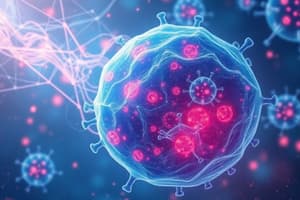Podcast
Questions and Answers
What is the main characteristic of Type I hypersensitivity reactions?
What is the main characteristic of Type I hypersensitivity reactions?
- Caused by overstimulation of T cells
- High levels of IgE are secreted upon re-exposure (correct)
- Mediated by IgG and IgM antibodies
- Slow onset within 2-24 hours
Which type of hypersensitivity is associated with immune complexes forming in response to free soluble antigens?
Which type of hypersensitivity is associated with immune complexes forming in response to free soluble antigens?
- Type IV
- Type II
- Type I
- Type III (correct)
What is the time frame for Type II hypersensitivity reactions to develop?
What is the time frame for Type II hypersensitivity reactions to develop?
- Takes days to weeks
- Immediate, within minutes
- Develops in 2-24 hours (correct)
- Occurs after several weeks
What distinguishes Type IV hypersensitivity from the other types?
What distinguishes Type IV hypersensitivity from the other types?
In Type II hypersensitivity, which of the following is a common outcome?
In Type II hypersensitivity, which of the following is a common outcome?
Which of the following is NOT a type of hypersensitivity reaction?
Which of the following is NOT a type of hypersensitivity reaction?
Which hypersensitivity type is best described by the presence of prolonged inflammation resulting in tissue damage?
Which hypersensitivity type is best described by the presence of prolonged inflammation resulting in tissue damage?
What is the primary cause of primary immunodeficiency?
What is the primary cause of primary immunodeficiency?
Which of the following is an example of a Type I hypersensitivity reaction?
Which of the following is an example of a Type I hypersensitivity reaction?
What mediates the tissue damage in Type III hypersensitivity?
What mediates the tissue damage in Type III hypersensitivity?
What is the primary characteristic of autoimmune diseases?
What is the primary characteristic of autoimmune diseases?
Which of the following is a common manifestation of Sjögren syndrome?
Which of the following is a common manifestation of Sjögren syndrome?
What type of autoimmune diseases are classified as organ-specific?
What type of autoimmune diseases are classified as organ-specific?
What is a potential consequence of secondary immunodeficiency?
What is a potential consequence of secondary immunodeficiency?
Which condition is characterized by desquamative gingivitis and changes in gingival health?
Which condition is characterized by desquamative gingivitis and changes in gingival health?
What is one oral manifestation commonly associated with pemphigus vulgaris?
What is one oral manifestation commonly associated with pemphigus vulgaris?
Which of the following factors does NOT contribute to secondary immunodeficiency?
Which of the following factors does NOT contribute to secondary immunodeficiency?
What effect does ciclosporin have on the oral cavity?
What effect does ciclosporin have on the oral cavity?
What is a characteristic feature of both Graves' and Hashimoto's diseases?
What is a characteristic feature of both Graves' and Hashimoto's diseases?
Which of the following conditions is often correlated with an increased risk of malignancy due to immune deficiencies?
Which of the following conditions is often correlated with an increased risk of malignancy due to immune deficiencies?
Flashcards
What is an autoimmune disease?
What is an autoimmune disease?
A group of disorders where the immune system attacks the body's own tissues.
What is immunodeficiency?
What is immunodeficiency?
The inability of the immune system to function properly, leaving the body vulnerable to infections and diseases.
What is Severe Combined Immunodeficiency (SCID)?
What is Severe Combined Immunodeficiency (SCID)?
A type of immunodeficiency characterized by severe impairment of both B and T cell function, resulting in a complete lack of immune response.
What are Complement Deficiencies?
What are Complement Deficiencies?
Signup and view all the flashcards
What are Granulocyte Defects?
What are Granulocyte Defects?
Signup and view all the flashcards
What is Autoimmunity?
What is Autoimmunity?
Signup and view all the flashcards
What are Organ-Specific Autoimmune Diseases?
What are Organ-Specific Autoimmune Diseases?
Signup and view all the flashcards
What are Generalized Systemic Autoimmune Diseases?
What are Generalized Systemic Autoimmune Diseases?
Signup and view all the flashcards
What is Xerostomia?
What is Xerostomia?
Signup and view all the flashcards
What is Sjögren's Syndrome?
What is Sjögren's Syndrome?
Signup and view all the flashcards
Hypersensitivity
Hypersensitivity
Signup and view all the flashcards
Type I Hypersensitivity
Type I Hypersensitivity
Signup and view all the flashcards
Type II Hypersensitivity
Type II Hypersensitivity
Signup and view all the flashcards
Type III Hypersensitivity
Type III Hypersensitivity
Signup and view all the flashcards
Type IV Hypersensitivity
Type IV Hypersensitivity
Signup and view all the flashcards
Immunodeficiency
Immunodeficiency
Signup and view all the flashcards
Primary Immunodeficiency
Primary Immunodeficiency
Signup and view all the flashcards
Secondary Immunodeficiency
Secondary Immunodeficiency
Signup and view all the flashcards
IgA Deficiency
IgA Deficiency
Signup and view all the flashcards
T and B cell defects
T and B cell defects
Signup and view all the flashcards
Study Notes
Hypersensitivity
- Hypersensitivity is an excessive immune response to an antigen, causing tissue damage on subsequent exposures.
- It's categorized into four types.
Type I Hypersensitivity
- Rapid onset: Symptoms develop within an hour of exposure.
- Mechanism: Allergens trigger the release of IgE antibodies, which bind to mast cells and basophils. Subsequent allergen exposure causes degranulation, releasing mediators like histamine.
- Examples: Allergies (e.g., hay fever, food allergies).
Type II Hypersensitivity
- Slow onset: Symptoms appear 2-24 hours after exposure.
- Mechanism: Antibodies (IgG and IgM) bind to cell surfaces, triggering complement activation or cell destruction by killer cells.
- Results: Opsonization, agglutination, and cell lysis.
- Examples: Blood transfusion reactions, some drug reactions, autoimmune anemias.
Type III Hypersensitivity
- Delayed onset: Symptoms develop over hours, days, or weeks.
- Mechanism: Antibodies (IgG and IgM) bind to soluble antigens, forming immune complexes that deposit in blood vessel walls. This activates complement, leading to inflammation and tissue damage.
- Examples: Systemic lupus erythematosus, serum sickness, rheumatoid arthritis.
Type IV Hypersensitivity
- Delayed onset: Symptoms appear 2 or more days after exposure.
- Mechanism: T cell and macrophage activation leads to cytokine release, causing inflammation, cell death, and tissue damage.
- Examples: Contact dermatitis, some autoimmune diseases.
Immunodeficiency
- Immunodeficiency is a weakened ability to fight off infections due to an impaired immune system.
Primary Immunodeficiency
- Cause: Genetic defects
- Characteristics: Increased susceptibility to serious infections, malignancies, and autoimmune diseases.
- Types: B cell, T and B cell, complement, and granulocyte deficiencies.
- Examples: Severe combined immunodeficiency (SCID), IgA deficiency, Papillon-Lefèvre syndrome.
Secondary Immunodeficiency
- Cause: Malnutrition, chronic infections, and immunosuppressant drugs.
- Characteristics: Increased risk of infections (viral and bacterial), poor wound healing, oral manifestations (candidiasis, periodontal disease).
- Examples: Malnutrition, HIV infections, chemotherapy.
Autoimmune Disease
- Autoimmune diseases occur when the immune system mistakenly attacks healthy tissues.
- Mechanism: Autoreactive T and/or B cells (autoantibodies or autoreactive T cells) target self-antigens.
- Types:
- Organ-specific: The disease targets specific body organs (e.g., thyroiditis, autoimmune gastritis).
- Systemic: The disease affects multiple organs (e.g., rheumatoid arthritis, systemic lupus erythematosus).
Oral Manifestations of Autoimmune Disease
- Sjögren syndrome: Xerostomia (dry mouth) and xerophthalmia (dry eyes).
- Systemic lupus erythematosus: Desquamative gingivitis, thrombocytopenia (low platelets).
- Pemphigus vulgaris: Ulcers and blisters in the oral cavity.
- Mucous membrane pemphigoid: Oral lesions, painful, and often chronic.
Studying That Suits You
Use AI to generate personalized quizzes and flashcards to suit your learning preferences.




